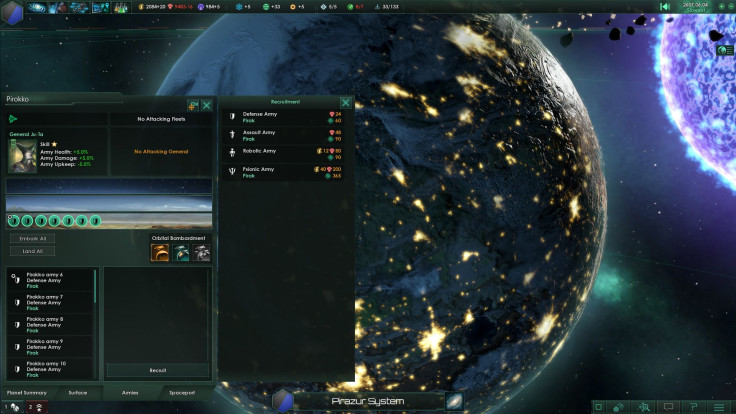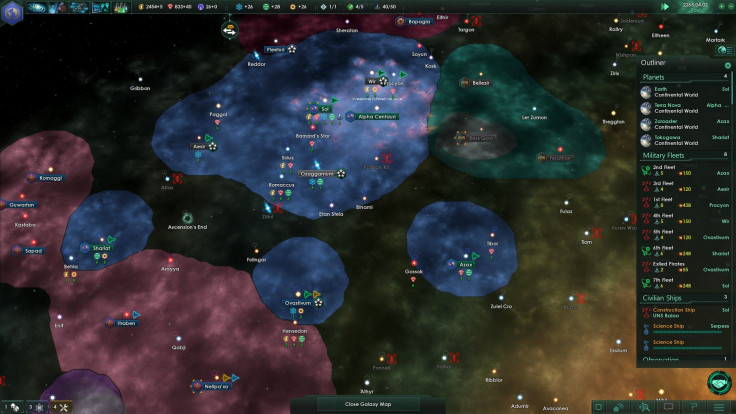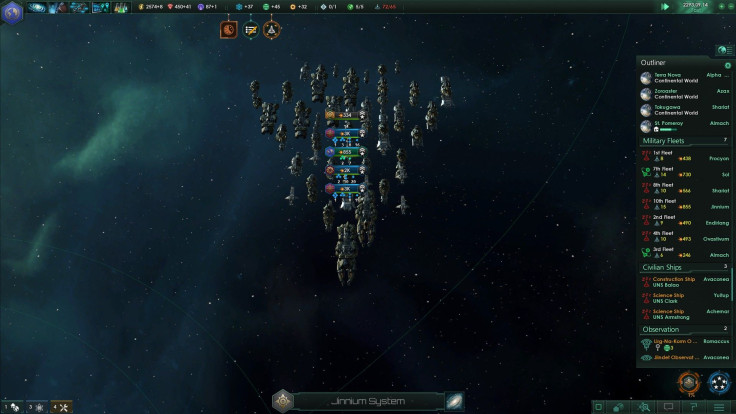Stellaris has been absolutely dominant this week. The game set several new sales records for its publisher, shot to the top of Steam’s Top Sellers chart — days before the debut of DOOM — and Stellaris is dominating much of the non- Uncharted discussion in comments sections and message boards around the web. It’s also responsible for rendering at least one member of the staff (yours truly) just about useless since Monday morning.
Naturally, after two days spent almost entirely researching or playing Stellaris, we’ve come up with a guide for anyone else diving into the game for their first time. Admittedly, our Beginner’s Guide isn’t complete, and will likely continue to evolve in the coming days. But this should be more than enough information to get you started and probably enough to guide you through your first couple of Stellaris play sessions.
Activate Details Mapmode

This one is pretty straightforward. In the bottom-right corner of the screen, locate the checkbox that activates Details Mapmode and make sure it’s been selected. This gives you considerably more information at a glance, from star systems with habitable planets to the available number and type of resources waiting to be claimed. It can be a bit daunting to look at, particularly from the galaxy map, but you’re going to need this information pretty frequently.
Survey Everything
Survey data is incredibly important in Stellaris. In addition to providing location data for new resource nodes, surveying is also how you discover anomalies (special research events) and new habitable planets to colonize. Once the game begins, your science ships should be on constant patrol for new star systems, stopping only to survey those you haven’t already scanned. They serve no military purpose, so there’s no need to keep them close by for defense purposes, and leaving them in Evasive mode usually ensures they’ll escape from any system that’s home to hostile forces.
Some players prefer Passive mode because ships will continue to survey hostile systems until fired upon. Just know it requires more micro-management to keep your ships safe. For every space amoeba that is largely content to ignore those who ignore it, there are dozens of pirates and other malevolent forces that won’t be so kind to an unguarded science ship.

Focus On Resources During The Early Game
You need a solid production foundation to build upon in the mid- and late-game. Population size affects many things in Stellaris, including your base research speed, meaning it's easy to leave yourself unable to match the development pace of competing empires if you don’t build enough research and mining stations. An early quest in Stellaris suggests players try to maintain a +10 Energy Credit / +30 Mineral Resource income ratio; however, many in the Stellaris community recommend keeping a higher energy credit surplus. We seem to hover around 15 energy and 25 minerals, but suspect the best numbers for each empire will depend on your current setup.
Build Up Your Military Early
Even if you prefer taking the pacifist approach in Stellaris, there are usually a dozen (or more) other empires on the board at any given time…and they don’t all share your love of peace. In addition to providing a basic line of defense for your homeworld, establishing a healthy military presence before focusing on expansion means you won’t have to sweat bullets (over fears of invasion) for the first few years after colonizing a new planet. Early on, you can generally get away with fleets that have at least 150 military power, since you’re unlikely to encounter much more than the occasional band of pirates. Just make sure you have a military presence in any star system you aren’t ready to lose.
Keep Your Influence Stream +2 Or Higher (Preferably Higher)
Having a steady stream of Influence is one of the most important things to secure for your empire. Democracies generally have a pretty healthy flow during the early game but it can be easy to overextend yourself, drying up your Influence without realizing it. Decommission any Frontier Outposts that have been rendered obsolete by nearby colonies and stay away from alliances during the early game. Both are major drains on your Influence stream, which never flows at anything higher than a trickle, and can be huge anchors on development if mishandled.
Prioritize Presidential Mandates

Each time your empire elects a new leader, he/she will enter office with some kind of mandate. If they’re a scientist, it’ll probably be a promise to build new mining or research stations. Political affiliation can also play a role in the mandate. While these missions aren’t required, the reward for following through on politicians’ campaign promises is usually 100-200 Influence. And that’s more Influence than many empires generate in a year.
Save Some Influence For A Rainy Day
One thing that Stellaris doesn’t do a great job of communicating to the player, until it’s too late, is that the scientists and other personnel hired by your empire eventually die. It makes sense, given the semi-realistic nature of the game, but doesn’t make the task of hiring a replacement any less expensive.
We learned this the hard way, after an unfortunate series of events left one of our empires down a research scientist and governor within the span of a few months. To make matters worse, we didn’t have enough influence to hire a replacement for either, much less both. Death isn’t the only threat, though. Members of your team will occasionally be elected president. When this happens, the demands of their new job will force them to abandon their current post for the next five years; even longer if they manage to get themselves re-elected.
Digging yourself out of that hole isn’t impossible but doing so can significantly stall development of your empire. Try to keep at least 50 influence on-hand at all times, maybe even 100 if your team is a bit older, so you can always replace a fallen/distracted leader at a moment’s notice.
Use Frontier Outposts For Early Expansion
Several requirements must be met before players can begin to assemble colony ships, the transport vessels used to establish colonies on habitable worlds outside your home system. But that doesn’t mean you can’t lay claim to some of the star systems near your homeworld while you wait for you science ship(s) to discover new planets worth colonizing. Frontier Outposts aren’t cheap and negatively impact your monthly Influence income. But they can be placed outside your existing borders and outposts are easily the most effective way to grab control of valuable star systems during the early stages of the game.
Use Trade To Improve Relations

Each time you make contact with a new empire, its leader will be added to the list of available diplomats on your Contacts screen. Next to each leader, a red or green number lets you know how favorably (or unfavorably) that empire views yours. The easiest way to improve relations between two empires is to establish an embassy, which automatically increases your favorability rating by one each month, but each player can only have three embassies at any given time. To improve relations with the rest of the field, you’ll need to rely on successful trade negotiations.
Queue Actions By Holding Shift
Ever wished you could give one of your ships a series of commands and then ignore it for a few months/years while you focus on other corners of your empire?
If so, we have some good news. You can!
All you need to do is hold the Shift button while selecting actions for one of your ships/fleets and the selected unit will complete each task in the order they were given.
Don’t Try To Expand Too Quickly

The attitudes of neighboring empires should play a big role in how fast you decide to expand during the early game. If the empires closest to you are peaceful, there’s a good chance you won’t need to worry about small gaps in your sphere of influence, since you should have a chance to fill them in before another empire colonizes the area. This is especially true if you maintain good relations with those neighbors.
Much like the Civilization franchise, building in an area that halts the growth of another nation is viewed as an act of aggression in Stellaris. Granted, it’s only a minor insult and not one that most empires will go to war over. But leaders with a positive opinion of your empire tend not to commit such acts as a result. In fact, we’ve seen rulers entirely change the directions they were exploring/expanding after entering into alliances with us, even ceding some border systems to our growing sphere of influence without complaint. Either way, we wouldn’t establish more than two additional colonies until you’ve made significant improvements to each new location.
But if your neighbors are aggressive, or you’ve been unfortunate enough to start in an area heavily infested by pirates, don’t build any colonies or outposts you can’t immediately defend with a fleet. You’re also going to want to expand your borders at a much slower rate, incorporating new colonies and star systems only once you’re certain you can defend them from an outside invasion. Otherwise, there’s a good chance you’re just making improvements that a rival empire will seize (or destroy). Its also important to remember there’s an economic penalty for outposts (permanent -1 Influence) and colonies (temporary -8 energy), so don’t build more than you can afford to support without impacting the growth of your empire.
Upgrade Your Colonies ASAP
Ethics drift can be devastating for a fledgling empire, particularly if your strategy for the game involved any kind of reliance on the Fanatical aspects of a species. Rather than let the populace of a new colony drift away from your empire’s core mission, make upgrading the Reassembled Ship Shelter on each new colony a priority. You won’t be able to initiate construction until at least five Pops reside on the planet, but try to get started as soon as possible.
Once you’ve upgraded the administrative building, build a spaceport for each colony currently under your control. We’d also recommending upgrading them once or twice, if you can afford it and have already completed the necessary research. You’ll need a healthy stockpile of energy credits and minerals to complete both projects but the outcome (happy, healthy and productive planets) more than justifies the cost. Improved colonies will also expand their borders much faster than their underdeveloped counterparts, giving players a chance to decommission nearby Frontier Outposts that are no longer needed.
Star Charts are a great way to break the ice with a new contact. Information about the galaxy is useful to everyone in Stellaris , regardless of political alignment or economic situation. Even if the other side’s charts are more valuable than your own, its usually pretty easy to make up the difference with a few energy credits or minerals. From there, try to negotiate a long-term deal, either swapping resources or (if they’re pacifists) maybe a non-aggression pact. Before you know it, the empire in question will practically be begging you to form/join an alliance.
Upgrade Your Fleets
By now, you’ve probably unlocked a few upgrades for the ship designer. What you may not have realized is that those upgrades aren’t automatically added to your existing ships. Like everything else in Stellaris , upgrading your fleet takes a combination of time and resources. Once you’ve managed to unlock a few upgrades, take some time to update the blueprints for your new ships, adding any new weapons or utility items you’ve unlocked since your last visit. Once you have some new schematics, it’s time to start upgrading your existing fleet.
Ships are upgraded one at a time, via the spaceports on colonized planets, so we recommend dividing large fleets into smaller ones and reforming after the upgrades are complete. Updating your schematics can be automated, by enabling Auto Assign in the ship designer, but you’ll still need to tell your fleets when to return to port for upgrades.
Allies Come With A Price

Players take a -2 penalty to their monthly Influence income when part of an alliance. That penalty disappears if/when the alliance becomes a full-fledged federation but convincing every member of the alliance to vote “yes” can be time-consuming. You’ll need to keep both facts in mind if/when some of your neighbors begin inquiring about forming an alliance. While there are plenty of benefits to formally allying yourself with another empire, like a helping hand in times of war, players considering such an arrangement should ensure they either have enough Influence to cover operations for a few years or can afford to pay the penalty without reducing their Influence income below the recommended level.
Proper Sector Management Is Key
Once your empire begins to expand, Stellaris will give players the option of establishing sectors in their controlled space. At first, players might be turned off by the thought of relinquishing the ability to micro-manage worlds under their control. After all, proper resource management is like 80 percent of the battle in games like Stellaris . But planets that have been added to a sector don’t count against your Directly Controlled Planet total, meaning you can return to colonizing new and valuable systems throughout the galaxy. Players can also transfer lump sums of energy credits and/or minerals to their sectors to ensure their product and growth doesn't slow down after you give up the ability to micro-manage the system.
Once established, players can specialize each sector, pushing residents to focus on gathering specific resources or improving the research rate of star systems in the sector. You can give the local governor permission to build over existing structures on the surface of colonized planets. Sectors can even be used to gerrymander minority factions during the late game, destroying that group’s ability to operate politically with any effectiveness. Bottom line: you need to be familiar with the sector management screen if you ever hope to win a game in Stellaris.
Always Choose Rare Research Opportunities
As you may have already figured out, Stellaris doesn’t rely on a technology “tree” like most games, with players gaining access to new units and skills as they work their way through a series of prerequisites. Instead, players are given three options chosen at random from a deck featuring all of the technologies that can be researched by your empire.
Occasionally, players will be presented with rare technologies, which can be easily identified by the purple border around their title. Rare technology generally takes much longer to research than its standard counterpart, but will also have a much greater impact on your society. If you do decide to skip out, it’s always possible you’ll get a second chance at that same rare technology again in a few months/years. But we’d recommend grabbing any rare tech put in front of you unless you just absolutely can’t envision a way it would be useful in your current situation.
Other Tips
“Pops” on the surface of each planet can be moved by dragging them from one tile to another.
Don’t build your empire’s capital on your species’ homeworld. Instead, wait until you have access to planet with 20+ surface tiles so you have plenty of room for advanced buildings.
Specialize your planets and sectors (i.e. one for energy, one for minerals, etc) to maximize their effectiveness during the late game.
Hovering over the Trade Acceptance value on the trade negotiation screen provides a detailed breakdown of the perceived value of the goods in the currently proposed trade.
Slavery is incredibly OP. We can’t endorse it, even digitally, but don’t say we didn’t tell you.
If you’re hitting the resource cap, use instant transfers of energy credits and/or minerals to reduce your stockpile and improve your relations with other empires
Military Stations and Wormhole Generators can be built outside your borders, too.
Frontier Outposts can be added to sectors. Once added, you’ll no longer pay upkeep on them and sectored outposts won’t count towards your current Influence penalty. (WARNING: There are reports this is a bug, not an intended feature, that could change in an upcoming patch.)
Don’t chase warp drive fleets to a new system if you also use warp drives. Upon arrival, the defenders will have a chance to attack you (during which you cannot return fire) while your ships wait for their systems to finish cooling down.
***
Be sure to check back with iDigitalTimes.com and follow Scott on Twitter for additional Stellaris coverage throughout 2016 and for as long as Paradox supports Stellaris in the months ahead.



















